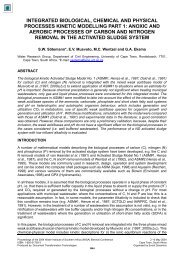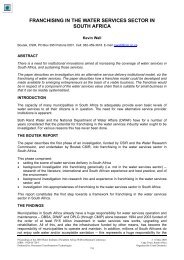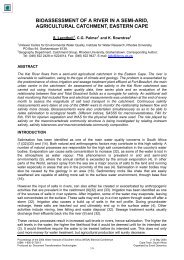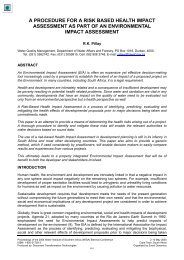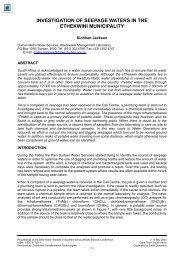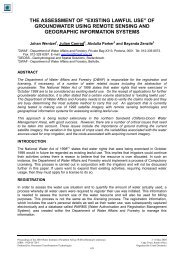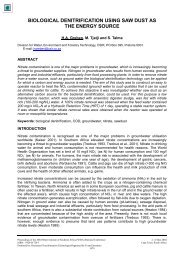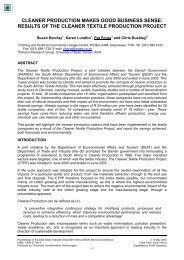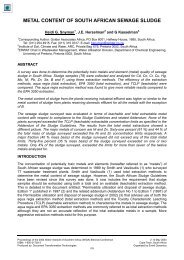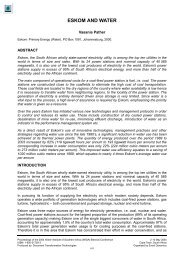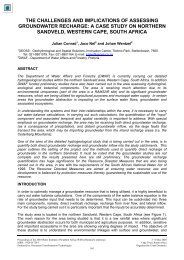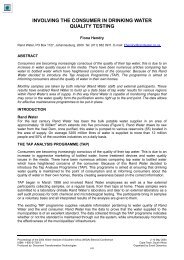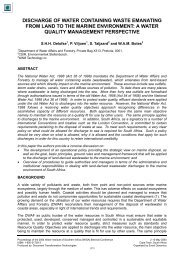Stochastic Analysis of Water Supply Systems Using ... - eWISA
Stochastic Analysis of Water Supply Systems Using ... - eWISA
Stochastic Analysis of Water Supply Systems Using ... - eWISA
Create successful ePaper yourself
Turn your PDF publications into a flip-book with our unique Google optimized e-Paper software.
STOCHASTIC ANALYSIS OF WATER SUPPLY SYSTEMS<br />
USING MOCASIM II<br />
H.A. Kretzmann, J.E. van Zyl and J. Haarh<strong>of</strong>f<br />
RAU <strong>Water</strong> Research Group, Department <strong>of</strong> Civil and Urban Engineering, Rand Afrikaans University,<br />
PO Box 524, Auckland Park 2006. Tel: (011) 489-2345. Fax: (011) 489-2148.<br />
E-mail: jevz@ing.rau.ac.za<br />
ABSTRACT<br />
A s<strong>of</strong>tware package called Mocasim II has been developed to perform stochastic analysis on water<br />
supply systems. This allows the relationship between the reliability <strong>of</strong> the supply system and the<br />
capacity <strong>of</strong> its service reservoir(s) to be quantified using Monte Carlo analysis. In a Monte Carlo<br />
analysis the factors which influence the reliability <strong>of</strong> the system such as water demand, fires, and<br />
pipe failures are simulated stochastically over a long period <strong>of</strong> time. A reliability/capacity<br />
relationship is quantified by analyzing the failure behavior <strong>of</strong> different service reservoir sizes. A<br />
previous version <strong>of</strong> Mocasim used a simple mass balance model for calculating the flows in simple,<br />
linear distribution networks. Mocasim II extends the functionality <strong>of</strong> its predecessor by enabling the<br />
probabilistic modeling <strong>of</strong> more complex water distribution models. This was achieved by<br />
integrating the stochastic modelling technique into the Epanet hydraulic analysis s<strong>of</strong>tware package.<br />
Mocasim II was designed using an object-oriented model which has various advantages such as<br />
ease <strong>of</strong> testing, upgrading and maintaining as well as minimum repetitive code and a logical<br />
structure. Additional capabilities <strong>of</strong> Mocasim II include the determination <strong>of</strong> probability distributions<br />
for network properties such as flow rate, pressure and water quality at any node in the network.<br />
This will assist in estimating the levels <strong>of</strong> service <strong>of</strong> a water supply system.<br />
INTRODUCTION<br />
<strong>Water</strong> planners and managers in South Africa are faced with new challenges due to the country’s<br />
water-stressed resources and the large percentage <strong>of</strong> the South African population living a<br />
considerable distance away from the closest water source. Large amounts <strong>of</strong> capital are being<br />
invested into providing all South Africans with a basic water supply. It is therefore important to<br />
optimize the design <strong>of</strong> water supply systems while still providing acceptable and affordable service.<br />
Service reservoirs are an important component <strong>of</strong> a water distribution system. They are storage<br />
containers for water, allowing the source to produce water at a constant rate while the consumer<br />
demand varies over time. The importance <strong>of</strong> a service reservoir is highlighted by the fact that when<br />
the supply from the source is interrupted, the reservoir is still able to supply consumers for a<br />
certain period <strong>of</strong> time.<br />
Table 1 lists some guidelines used in South Africa when designing a water distribution system. As<br />
can be seen from this table, the size <strong>of</strong> a reservoir is usually a function <strong>of</strong> the annual average daily<br />
demand (AADD).<br />
Although these guidelines have served the industry and public well, they do not take the supply<br />
area’s unique properties, such as size and land use into account. Another limitation is that the<br />
relationship between the feeder pipe and the service reservoir is fixed, preventing the designer<br />
from exploring the most economic combination <strong>of</strong> feeder pipe and service reservoir. The service<br />
reservoirs probability <strong>of</strong> failure is also not considered when making use <strong>of</strong> such rigid guidelines.<br />
Proceedings <strong>of</strong> the 2004 <strong>Water</strong> Institute <strong>of</strong> Southern Africa (WISA) Biennial Conference 2 –6 May 2004<br />
ISBN: 1-920-01728-3 Cape Town, South Africa<br />
Produced by: Document Transformation Technologies Organised by Event Dynamics
Table 1. Typical South African guidelines for sizing reservoirs and feeder pipes.<br />
Authority<br />
Nature <strong>of</strong> supply<br />
Feeder<br />
capacity<br />
Service reservoir<br />
capacity<br />
gravity feed 1.5 x AADD 24h <strong>of</strong> AADD<br />
Department <strong>of</strong> <strong>Water</strong><br />
Affairs pumped main 1.5 x AADD 48h <strong>of</strong> AADD<br />
Co-operation & gravity feed 1.5 x AADD 24h <strong>of</strong> AADD<br />
Development pumped main 1.5 x AADD 48h <strong>of</strong> AADD<br />
National Building one source 1.5 x AADD 48h <strong>of</strong> AADD<br />
Institute two sources 1.5 x AADD 36h <strong>of</strong> AADD<br />
National Housing<br />
<strong>Supply</strong><br />
pipe size<br />
gravity feed 1.5 x AADD 20h <strong>of</strong> AADD<br />
pumped main 1.5 x AADD 30h <strong>of</strong> AADD<br />
two sources 1.5 x AADD 66% <strong>of</strong> capacity with<br />
one source<br />
Reliability<br />
Service<br />
reservoir size<br />
Figure 1. Interrelationship amongst bulk water supply variables.<br />
Figure 2. Typical water demand pattern.
A triangular relationship is shown in Figure 1 between the reliability <strong>of</strong> a bulk water supply system,<br />
the capacity <strong>of</strong> the service reservoir(s) and the size <strong>of</strong> the supply pipeline. The size <strong>of</strong> the service<br />
reservoir depends directly on the capacity <strong>of</strong> the bulk water supply pipeline. Figure 2 is a typical<br />
water demand pattern. If the supply rate is Qmax, no reservoir is needed, because the peak demand<br />
can be supplied directly from the pipeline. If the supply rate is less than Qave, an infinitely large<br />
reservoir is required, because the long-term demand exceeds the supply capacity. Naturally, it<br />
follows that larger reservoirs would require smaller pipelines, and vice versa.<br />
A water distribution system has a great effect on the quality <strong>of</strong> life <strong>of</strong> its consumers. It is important<br />
that consumers are supplied with a sufficient amount <strong>of</strong> water that is <strong>of</strong> an acceptable quality. As<br />
seen in Figure 1, the reliability <strong>of</strong> supply plays a major role. Lewis (1) described reliability as<br />
follows: “In the broadest sense, reliability is associated with dependability, with successful<br />
operation, and with the absence <strong>of</strong> breakdowns or failures. It is necessary for engineering analysis<br />
however, to define reliability quantitatively as a probability. Thus reliability is defined as the<br />
probability that a system will perform its intended function for a specified period <strong>of</strong> time under a<br />
given set <strong>of</strong> conditions. A product or system is said to fail when it ceases to perform its intended<br />
function.”<br />
Since the main function <strong>of</strong> the bulk supply systems is to supply reservoirs, and not consumers, the<br />
reliability <strong>of</strong> these systems can be defined in terms <strong>of</strong> their ability to maintain water in the reservoir.<br />
A reservoir that runs dry would be a failure event in the bulk water supply system. The reliability <strong>of</strong><br />
a bulk supply system can therefore be described in terms <strong>of</strong> the failure behaviour <strong>of</strong> its reservoir,<br />
for instance in terms <strong>of</strong> the annual number <strong>of</strong> failure events, the total annual fail time, or the<br />
average failure duration.<br />
Larger reservoirs would fail less <strong>of</strong>ten and would thus provide a higher level <strong>of</strong> reliability. However,<br />
the higher reliability comes at a cost <strong>of</strong> increased capital expenditure and the potential for water<br />
quality problems due to longer retention times in the reservoir. In some cases it might be better to<br />
improve the reliability <strong>of</strong> the system by increasing the capacity <strong>of</strong> the supply pipelines, changing<br />
the pipe configuration, or reducing the time for finding and repairing pipe bursts.<br />
MOCASIM II<br />
Mocasim II is a s<strong>of</strong>tware package that combines probabilistic analysis with hydraulic analysis. It<br />
allows various types <strong>of</strong> analysis to be performed such as capacity versus reliability analysis for<br />
reservoirs. A previous version <strong>of</strong> Mocasim used a simple mass balance model for calculating the<br />
flows in simple, linear distribution networks. Mocasim II extends the functionality <strong>of</strong> its predecessor<br />
by enabling the probabilistic modelling <strong>of</strong> more complex water distribution models. This was<br />
achieved by integrating a stochastic modelling technique into the Epanet hydraulic analysis<br />
s<strong>of</strong>tware package. Mocasim II was designed using an object-oriented model which has various<br />
advantages such as ease <strong>of</strong> testing, upgrading and maintaining as well as minimum repetitive code<br />
and a logical structure.<br />
The methodology used in Mocasim II was developed as part <strong>of</strong> a research initiative by the <strong>Water</strong><br />
Research Group at the Rand Afrikaans University. The motivation behind the methodology was to<br />
enable the analysis <strong>of</strong> service reservoir reliability using stochastic analysis. <strong>Stochastic</strong> analysis is<br />
useful for evaluating system reliability in a wide range <strong>of</strong> fields, including water supply distribution,<br />
electrical power distribution, and communications networks (2). It is frequently used in the analysis<br />
<strong>of</strong> complex systems where risk and uncertainty play important roles.<br />
A stochastic model is one whose outputs are predictable only in a statistical sense. With a<br />
stochastic model, repeated use <strong>of</strong> a given set <strong>of</strong> model inputs produces outputs that are not the<br />
same but follow certain statistical patterns (3). The stochastic method used in this methodology is<br />
the Monte Carlo simulation method. Monte Carlo methods have been used for centuries, but only<br />
in the past several decades has the technique gained the status <strong>of</strong> a recognised numerical method<br />
capable <strong>of</strong> addressing the most complex applications.
Monte Carlo simulation entails the repeated calculation <strong>of</strong> the system performance, each time with<br />
a different combination <strong>of</strong> input parameters. The input parameters are randomly selected from<br />
probability distribution functions. For example, we may know that the minimum time required to<br />
repair a burst on a particular pipe is 3 hours, the maximum 36 hours and the median 12 hours. By<br />
fitting a suitable function to these values, a probability distribution function may be defined which<br />
can then be used in the stochastic analysis to simulate the pipe’s failure duration behaviour.<br />
The input parameters are those stochastic variables, which affect the system: consumer demand,<br />
fire-fighting demand and emergency storage requirements. Once estimates <strong>of</strong> the probability<br />
distributions <strong>of</strong> these components are available, Monte Carlo simulation is used to generate<br />
stochastic combinations <strong>of</strong> these variables for any required number <strong>of</strong> iterations, each iteration<br />
covering a time step <strong>of</strong> arbitrary length, typically one hour time steps over 10 000 years. The<br />
performance <strong>of</strong> the system is then reported statistically.<br />
The performance criterion used for bulk water supply systems is whether the amount <strong>of</strong> water in<br />
storage at the beginning <strong>of</strong> a time step, plus the inflow during the step, is more than the water<br />
leaving the tank. If so, the supply to the customers is not interrupted and the system is successful.<br />
If not, it implies that the tank will be empty for at least a part <strong>of</strong> the time step and a failure is<br />
recorded. The process is repeated for each successive time step, with the tank level adjusted for<br />
the net in/outflow after each step.<br />
INPUT PARAMETERS<br />
Very few reservoirs perform only one function; they have to provide more than one or all <strong>of</strong> the<br />
functions listed below:<br />
Emergency Storage<br />
Volume must be provided to guarantee the supply to the consumers, even when the supply to the<br />
service reservoir is partially or completely discontinued. Such events may be scheduled for<br />
maintenance purposes, which is not a stochastic variable. More important for probabilistic analysis<br />
are the unscheduled events due to pipe, power or source failures. The volume required for these<br />
unscheduled events is stochastic, as neither the time <strong>of</strong> occurrence nor the duration <strong>of</strong> the<br />
interruption can be predicted.<br />
Fire Storage<br />
It is essential to have an adequate water supply available for fire-fighting. This is mostly supplied<br />
through the water reticulation system, and is thus also drawn from the service reservoir. Most<br />
guidelines will specify an additional volume <strong>of</strong> water for which allowance must be made in the<br />
storage tank. This approach is based on the conservative assumption that the fire demand will<br />
coincide with a period <strong>of</strong> maximum consumer demand. The required fire storage is stochastic, as<br />
neither the time <strong>of</strong> occurrence nor the actual volume required can be predicted.<br />
Demand Storage<br />
Consumers draw water from a service reservoir at a variable rate, whereas the supply line usually<br />
delivers water at a constant rate. The reservoir has to absorb the difference between inflow and<br />
outflow rates. The flow from the supply line into the tank is easily determined and usually well<br />
controlled. The consumer demand, on the other hand, is determined by the cumulative effect <strong>of</strong> a<br />
multitude <strong>of</strong> stochastic variables and is therefore itself a stochastic variable.<br />
Operational Requirements<br />
There could be additional requirements for service reservoir volume, such as freeboard (dependent<br />
on the sophistication <strong>of</strong> level sensing and control equipment), bottom storage (dependent on the<br />
potential <strong>of</strong> air or sediment entrainment at the outlet), or a pump control band (required for<br />
automatic switching <strong>of</strong> pumps if water is being pumped to or from the reservoir). These<br />
components are all deterministic, i.e. they can be calculated once and simply added to the volume<br />
required for the stochastic components described above.
MODEL FOR EMERGENCY STORAGE<br />
The volume required for emergency storage is equivalent to the total water demand for the<br />
duration <strong>of</strong> the supply interruption. To determine the emergency storage volume, we need to<br />
estimate two factors; the first is the frequency <strong>of</strong> supply interruptions and the second is the duration<br />
<strong>of</strong> the interruption. The supply to a service reservoir is interrupted when the raw water source or<br />
water treatment plant fails, pumping installations fail (e.g. due to power cuts), or the feeder pipe<br />
system fails (e.g. pipe breaks). These reasons for supply interruptions are the most common,<br />
however only pipe failures are considered here, as they are the most common cause <strong>of</strong> prolonged<br />
supply interruptions in practice.<br />
Frequency <strong>of</strong> <strong>Supply</strong> Interruptions<br />
To model the frequency <strong>of</strong> pipe breakages, it is necessary to know the length <strong>of</strong> the pipe and the<br />
average pipe breakage rate. From these two values the average number <strong>of</strong> breaks per year can be<br />
calculated. On any given day, the probability <strong>of</strong> a break is then the number <strong>of</strong> breaks per year<br />
divided by the number <strong>of</strong> days per year. Now, a random number between 0 and 1 can be<br />
generated – if the number is less than the probability, a break is assumed. If a break is assumed,<br />
the duration <strong>of</strong> the interruption must then be estimated.<br />
Duration <strong>of</strong> <strong>Supply</strong> Interruptions<br />
The total interruption time associated with a pipe break is assumed to be the sum <strong>of</strong>:<br />
• Reporting time from the instant <strong>of</strong> break until the maintenance centre is notified<br />
• Mobilization time to assemble crew, spares, equipment and vehicles<br />
• Travel time from maintenance centre to point <strong>of</strong> break<br />
• Preparation time, i.e. shutting valves, draining pipeline, and excavation to the level <strong>of</strong> the pipe<br />
break<br />
• Repair time, and<br />
• Commissioning time, i.e. disinfection, air bleed, and controlled restoration <strong>of</strong> full pipeline<br />
pressure<br />
The total interruption time for rural and urban areas will be dominated by completely different<br />
factors. In urban situations, the reporting and travel times will be minimal, as any break will be<br />
immediately visible and the maintenance centre is usually situated close by within the urban area.<br />
It can be expected that the excavation and repair time in a congested area, shared by numerous<br />
other services, will have to be slow and careful. For rural areas, the total interruption time is<br />
dominated by reporting and travel times due to remote location, absence <strong>of</strong> the people, and poor<br />
roads and communications. Excavation and repair time, however, will be shorter due to<br />
unrestricted room and mostly smaller pipeline diameters.<br />
To model the duration <strong>of</strong> these interruptions in a probabilistic way, it is necessary to have: a<br />
statistical distribution that adequately fits the observed or anticipated interruption, the mean<br />
interruption time, and the coefficient <strong>of</strong> variation describing the variability <strong>of</strong> the interruption time<br />
about the mean.<br />
MODEL FOR FIRE STORAGE<br />
The total volume <strong>of</strong> water used for each fire is required to determine the effect <strong>of</strong> fire-fighting on the<br />
reliability <strong>of</strong> bulk water supply systems. The fire volume can be calculated as the fire duration<br />
multiplied by the fire flow rate.<br />
Fire Duration and Flow Rate<br />
The mean, statistical distribution and standard deviation <strong>of</strong> the fire duration and fire flow rate must<br />
be obtained to get a probabilistic estimate <strong>of</strong> the volume required for fire-fighting.<br />
To get a true probabilistic estimate, the fire duration as well as the fire flow rate has to be described<br />
in statistical terms. The mean, the appropriate statistical distribution and the standard deviation<br />
must be obtained from municipal records, if available.
Such data is rarely available in South Africa, and their retrieval and analysis are extremely tedious.<br />
Furthermore, as large fires are rather infrequent, most <strong>of</strong> the sources will yield too few data points<br />
to allow meaningful statistical analysis. A much simpler, more direct approach is to get a<br />
deterministic estimate from the relevant fire codes. These codes usually specify both the maximum<br />
fire flow rate and the fire duration as a function <strong>of</strong> the land use category, population density, or<br />
other parameters. By multiplying these values, an estimate can be obtained.<br />
Probability <strong>of</strong> a Fire Occurring<br />
It is difficult to estimate the probability <strong>of</strong> a fire occurring in the supply area <strong>of</strong> a water supply<br />
system, even if historical records would be available. Most fires require very little or no fire water<br />
from the water supply system, and these smaller fires are obviously <strong>of</strong> no consequence for the<br />
design <strong>of</strong> the supply system. What is really needed, is the probability <strong>of</strong> a large fire occurring; a fire<br />
that will exert a substantial demand from the supply system. This is especially important if the fire<br />
water volume is estimated from the local fire code, as this value indicates an extreme fire event.<br />
MODEL FOR WATER DEMAND<br />
An actual water demand pattern is the sum <strong>of</strong> two sets <strong>of</strong> factors: (1) a number <strong>of</strong> cyclic factors,<br />
introduced by the seasons <strong>of</strong> the year or the days <strong>of</strong> the week, and (2) a random factor, which is<br />
introduced by the cumulative effects <strong>of</strong> unaccounted-for variables such as temperature, rainfall,<br />
holidays, special events within the supply area, etc.<br />
The first step in estimating the daily volume <strong>of</strong> water used is to select a random value from an<br />
appropriate distribution function with a mean and standard deviation.<br />
An important factor to include is that <strong>of</strong> serial correlation. Serial correlation (also called<br />
autocorrelation) occurs when residuals from adjacent measurements in a time series are not<br />
independent <strong>of</strong> one another (that is, if the i th residual is high, it is likely that the (i+1) th residual will<br />
also be high, and likewise low residuals tend to follow other low residuals).<br />
Daily water demand data normally exhibit a strong degree <strong>of</strong> serial correlation. For example, if<br />
yesterday had a higher-than-average demand, today is also likely to have a higher-than-average<br />
demand. Behavior <strong>of</strong> this kind is statistically described with a serial correlation coefficient Φ. The<br />
correlation coefficient measures the similarity <strong>of</strong> variation <strong>of</strong> two residuals. Correlation coefficients<br />
range from +1 (which indicates a perfect linear relationship between two residuals), to 0 (which<br />
indicates absolutely no relationship), to –1 (for a perfect inverse linear relationship). A correlation<br />
coefficient between 0 and +1 means that the variables increase or decrease together, but not<br />
identically.<br />
The analysis <strong>of</strong> numerous South African data sets have shown that it is only necessary to take one<br />
preceding day into account as further serial correlation coefficients are not significant.<br />
The cyclic factors must be incorporated. These factors are the following:<br />
• systematic day-to-day variations found in a typical week. The average daily volume for a<br />
particular day is calculated by multiplying by a peak factor PFMon…Sun.<br />
• systematic annual seasonal variations which can be described in terms <strong>of</strong> 12 months <strong>of</strong> 52<br />
weeks. The average daily volume for each <strong>of</strong> these time units, is calculated by multiplying by<br />
an appropriate peak factor PF1…13.<br />
Finally, the daily volume must be dimensionalized by multiplying it with the Annual Average Daily<br />
Demand AADD.<br />
If the simulation is done with a time step <strong>of</strong> one day, the above model is complete. If a time step <strong>of</strong><br />
one hour is used the approach is to generate a daily volume as indicated above, and then to<br />
disassemble the daily volume into 24 hourly volumes according to a fixed hourly pattern. The fixed<br />
hourly pattern is defined by PF1…24.
APPLICATION EXAMPLE<br />
A network similar to that in an EPANET tutorial has been chosen to demonstrate the capabilities <strong>of</strong><br />
MOCASIM II. The network consists <strong>of</strong> a lake and a river as two sources, three service reservoirs,<br />
92 nodes and pipes with a total length <strong>of</strong> approximately 80km. The network is shown in Figure 3.<br />
The average annual daily demand for the entire network is 685 l/s.<br />
Figure 3. Example network.<br />
The same failure model was applied to all the pipes. This model has an average failure rate <strong>of</strong> 0.23<br />
failures per km per year. One demand model was used which consisted <strong>of</strong> an hourly demand<br />
pattern and a random component. The demand model was applied to four nodes at peak demand.<br />
The hourly demand pattern is depicted graphically in Figure 4 and Table 2 lists the input<br />
parameters used in the reliability analysis <strong>of</strong> the system.<br />
2.5<br />
2<br />
1.5<br />
1<br />
0.5<br />
0<br />
1<br />
3<br />
5<br />
Ratio <strong>of</strong> Hourly Average<br />
7<br />
9<br />
11<br />
13<br />
15<br />
Hour <strong>of</strong> the day<br />
17<br />
19<br />
Figure 4. Hourly demand pattern.<br />
21<br />
23
Demand Model<br />
Fail Model<br />
Service Reservoirs<br />
Table 2. MOCASIM II parameters.<br />
Units Parameter<br />
ID FailM1<br />
Patterns<br />
Seasonal Pattern none<br />
Day <strong>of</strong> Week Pattern none<br />
Hourly Pattern 1<br />
Correlation Coefficient 0.4<br />
Random Component<br />
Distribution normal<br />
Average 1<br />
Standard Deviation 0.2<br />
ID<br />
Fail Frequency<br />
Distribution lognormal<br />
Average #/km/year 0.23<br />
Standard Deviation 0.0322<br />
Fail Duration<br />
Distribution lognormal<br />
Average h 6<br />
Standard Deviation 0.84<br />
ID 1<br />
Elevation m 40<br />
Min storage size kl 14778.8<br />
Max storage size kl 500000<br />
Storage size factor 1<br />
Storage size additional 14778.8<br />
ID 2<br />
Elevation m 36<br />
Min storage size kl 14778.8<br />
Max storage size kl 500000<br />
Storage size factor 1<br />
Storage size additional 14778.8<br />
ID 3<br />
Elevation m 39<br />
Min storage size kl 14778.8<br />
Max storage size kl 5000000<br />
Storage size factor 1<br />
Storage size additional 14778.8<br />
The simulation was run for a duration <strong>of</strong> 1000 years for each service reservoir. This duration was<br />
adequate to get accurate enough results as the simulation was applied to the nodes at peak<br />
demand. The results <strong>of</strong> the reliability for each service reservoir can be seen in Figure 5. It must be<br />
noted that the AADD used for each reservoir is that <strong>of</strong> the entire system.<br />
It can be seen from the graph that the reliability <strong>of</strong> service reservoir 3 (0.02 failures per year at 72<br />
hours AADD) is much better than that <strong>of</strong> service reservoir 1 which has a failure rate <strong>of</strong> 244 per year<br />
at a capacity <strong>of</strong> 72 hours AADD, and service reservoir 2 which has a failure rate <strong>of</strong> 0.4 at the same<br />
capacity. The reason for this is due mainly to two factors. Firstly the distance <strong>of</strong> the reservoir from<br />
the source plays an important role as the closer the reservoir is to the source, the fewer failures will
occur resulting in an improved reliability. The second factor is that <strong>of</strong> the size <strong>of</strong> the area which is<br />
supplied by the reservoir, because the AADD for the entire system was used to size the reservoirs.<br />
Service reservoir 1 supplies a larger area than that <strong>of</strong> service reservoir 2, thus resulting in a lesser<br />
reliability.<br />
No. failures (p.a)<br />
1000<br />
100<br />
10<br />
1<br />
0.1<br />
0.01<br />
6 12 18 24 30 36 42 48 54 60 66 72 80 84<br />
Reservoir Capacity (Hours AADD <strong>of</strong> System)<br />
Figure 5. Reliability analysis <strong>of</strong> three service reservoirs.<br />
Reservoir 1<br />
Reservoir 2<br />
Reservoir 3<br />
Another capability <strong>of</strong> MOCASIM is demonstrated in Figure 6 and Figure 7, which show the demand<br />
distributions <strong>of</strong> two nodes. Figure 8 and Figure 9 show the pressure distribution <strong>of</strong> the same two<br />
nodes. These distributions quantify the service provision <strong>of</strong> the system. It could be seen from the<br />
results obtained that the pressure at node 15 only dropped below 24 m (the minimum allowable<br />
pressure for a distribution system) for 0.2 % <strong>of</strong> the time, but never dropped below 20 m. Similar<br />
deductions can be made from the distribution <strong>of</strong> node 121. The statistical properties <strong>of</strong> these<br />
distributions appear in Table 3.<br />
Probability<br />
Probability<br />
1.2<br />
1<br />
0.8<br />
0.6<br />
0.4<br />
0.2<br />
0<br />
0 5 10 15 20 25 30 35 40 45<br />
Demand (l\s)<br />
Node 15<br />
Figure 6. Demand distribution <strong>of</strong> node 15<br />
1.2<br />
1<br />
0.8<br />
0.6<br />
0.4<br />
0.2<br />
0<br />
0 1 2 3 4 5 6 7 8 9 10<br />
Demand (l/s)<br />
Node121<br />
Figure 7. Demand distribution <strong>of</strong> node 121.
Probability<br />
Probabilty<br />
1.2<br />
1<br />
0.8<br />
0.6<br />
0.4<br />
0.2<br />
0<br />
0 202326293235384144475053565962<br />
Pressure (m)<br />
Node 15<br />
Figure 8. Pressure distribution <strong>of</strong> node 15.<br />
1.2<br />
1<br />
0.8<br />
0.6<br />
0.4<br />
0.2<br />
0<br />
35 38 41 44 47 50 53 56 59 62 65 68 71 74<br />
Pressure (m)<br />
Node 121<br />
Figure 9. Pressure distribution <strong>of</strong> node 121.<br />
Table 3. Statistical properties <strong>of</strong> distributions.<br />
Property Node Average (l/s) Std Deviation Minimum (l/s) Maximum (l/s)<br />
Demand 15 17.51 5.65 6.04 44.34<br />
Demand 121 2.99 0.89 1.79 5.43<br />
Pressure 15 38.70 5.28 20.00 60.19<br />
Pressure 121 53.67 4.18 39.18 72.35<br />
Table 4 also contains useful results for analysing distribution systems. It lists 6 pipes in the<br />
network, the number <strong>of</strong> failures that occurred per year and the failure duration statistics for each<br />
pipe. We can see from the table that longer pipes fail more <strong>of</strong>ten than shorter pipes.<br />
Table 4. Failure behaviour <strong>of</strong> pipes.<br />
Duration Statistics<br />
Pipe Length (m) No <strong>of</strong> failures Average (h) Std Deviation Minimum (h) Maximum (h)<br />
20 302 0.08 5.93 0.52 5.19 6.55<br />
103 411.5 0.09 5.49 0.78 4.05 6.45<br />
114 2000 0.45 5.91 0.66 4.63 7.21<br />
131 987.5 0.22 6.24 0.68 4.94 7.93<br />
204 1380.7 0.32 5.94 0.74 4.21 7.35<br />
247 1306 0.3 5.91 0.77 4.61 8.09<br />
It is important to note that in a stochastic model such as this, the values obtained will not be<br />
precisely the same for different simulations <strong>of</strong> a particular set <strong>of</strong> input data, but the results from<br />
each simulation will lead to the same conclusions.
CONCLUSION<br />
A s<strong>of</strong>tware package, MOCASIM II was introduced which combines probabilistic analysis and<br />
hydraulic analysis <strong>of</strong> water distribution systems. It allows various types <strong>of</strong> analysis to be performed<br />
such as capacity versus reliability analysis for service reservoirs. From the application example it is<br />
clear that the s<strong>of</strong>tware is a powerful tool to investigate different scenarios for upgrading or<br />
enlarging an existing water supply system, while maintaining an acceptable and predetermined<br />
probability <strong>of</strong> failure.<br />
REFERENCES<br />
1. E. Lewis, Introduction to Reliability Engineering, John Wiley & Sons, Inc. (1996).<br />
2. S. Yang, N.-S. Hsu, P. Louie and W.-G. Yeh, <strong>Water</strong> distribution network reliability: <strong>Stochastic</strong><br />
simulation, Journal <strong>of</strong> Infrastructure <strong>Systems</strong>, 2 (2). (1996).<br />
3. C. T. Haan, Statistical Methods in Hydrology, The Iowa State University Press/ Ames (1977).



